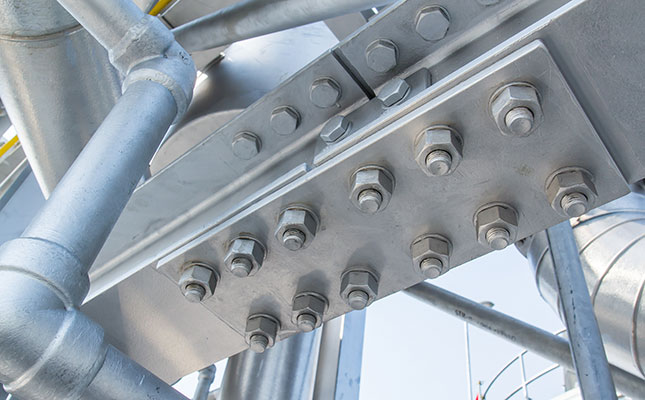
In this article, we’ll talk about steelwork structural bolts, how they’re categorised and what systems are available on the market.
Structural bolts have become essential after European standards EN 14399, EN 15048, and EN 1090-2 have become effective.
These standards define the characteristics of steelwork structural bolts, which are currently divided into two types, depending on the assembly to be made:
* Preload bolt assemblies (EN 14399), made with HV, HR and HRC systems
* Non-preload bolt assemblies (EN 15048), also known as SB (Structural Bolts).
Generally, the components that make up an assembly are a screw and a nut (EN 15048) or a screw, a nut and a double washer (EN 14399).
Preload bolt assemblies (EN 14399)
Preload bolts with controlled clamping force are applied when the structure or joint to be made is stressed by tensile strength.
Preload bolt assemblies are divided into three types: HV, HR and HRC.
HV and HR systems are basically equivalent. The main difference lies in their breakage in case of stress. HV (German) bolts use a lower nut so that they will be the first to break when under tensile strength. The internal thread will tear only afterwards. HR (French) bolts use a higher bolt and longer thread lengths. This difference makes the clamping force reduce differently, promoting greater bolt elongation and thus its breakage. Moreover, HV systems use class 10.9 screws, whereas HR systems can also include class 8.8 screws.
Remember that we are talking about controlled clamping assemblies. Therefore, the preload is applied through a torque wrench. This way, you can control the tightening torque applied to the assembly. The k factor determines the tightening torque performance based on the applied preload. This factor is essential for torque retention, but it depends on many factors, which can be difficult to control.
Some of these factors depend on the friction strength that forms between various elements, which are influenced by other factors, such as clamping speed, the roughness of contact surfaces, coupling tolerances, or any heat and/or surface treatment applied. Therefore, controlled clamping bolts are sensitive to even the slightest change, such as changes in the finishes. That’s why the assembly must be supplied in sealed boxes with the suitability test report issued by the manufacturer, without the possibility of using different lots.
Both bolt assemblies require the CE marking and the manufacturer’s trademark. Moreover, the screws and bolts must be stamped with their system designation, HR or HV (H for washers).
The HRC system eliminates the doubts related to the application to the correct tightening torque. In this assembly, bolts are tightened using an electric screwdriver with stacked torques, which scientifically controls the applied preload.
This tool acts on the tightening torque using a double tightening system. The first of these systems turns the nut while the other one holds the screw hooking onto its protruding part, which breaks during the second tightening stage when the nut stays still while the screw rotates (to the other side). Once the protruding part of the screw reaches its maximum resistance, it will detach, thus reaching the correct final tightening. In this case, the preload level is defined by the same HCR tightening system.
The conformity of components and assemblies to the EN 14399 standard is required and must be demonstrated through two tests:
* Initial type testing
* Periodical audit
Both tests monitor the product’s dimensional, mechanical and functional characteristics and must be carried out by the manufacturer.
Moreover, each product must include the Declaration of Performance (DoP), which must state all the characteristics required by the regulations and at least one of the product’s expected performance outcome.
Non-preload bolt assemblies (EN 15048)
Structural bolt assemblies (SB) do not require controlled clamping. Therefore, manual tightening is enough to reach the “snug-tight” condition. Clearly, since the applied preload is reduced, you can use all types of screws, regardless of the resistance class.
What really matters is that all the bolts must reach the snug-tight condition so as to have even clamping.
Avoiding over-tightening is crucial, especially when screws are short.
The tightening procedure to reach the snug-tight condition must be followed starting from the junction’s rigid parts towards the less rigid ones.
The screw must protrude with at least one full thread from the side that doesn’t rest on the nut.
This system differs from the previous ones not only for its clamping method but also for its application. In fact, the SB system (EN 15048) is designed to be used in structural bolting connections for shear loading. Even in this case, the nut-bolt assembly suitability test is required, as well as the application of the CE marking and the manufacturer’s trademark.
Both standards (EN 14399 and EN 15048) follow precise packaging rules for:
*Single packaging containing nut + screw for SB assemblies and nut + screw + washers for HV, HR, and HRC assemblies with pieces from one lot.
*Separate packaging for nuts, screws and washers from one lot on which the manufacturer has indicated the tightening characteristics.
Steelwork bolts require special attention because they are high-level products. That’s why collaborating with trusted partners is so important.
VIPA ensures excellent technical support and the utmost attention when supplying structural bolts. We have a controlled supply chain for EN 14399-compliant systems. And, as we are certified, we can take full responsibility for EN 15048-compliant systems as if we were the actual manufacturer.